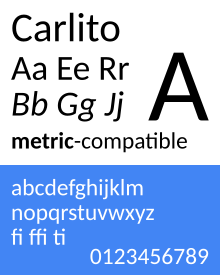 | |
| Category | Serif |
|---|---|
| Classification | Transitional |
| Foundry | Ascender Corporation |
| License | Apache License 2.0 |
| Variations | Liberation Serif |
| Website | fonts |
| Metrically compatible with | |
 | |
| Category | Monospaced |
|---|---|
| Classification | |
| Foundry | Ascender Corporation |
| License | Apache License 2.0 |
| Variations | Liberation Mono |
| Website | fonts |
| Metrically compatible with | |
 | |
| Category | Serif |
|---|---|
| Foundry | Huerta Tipográfica |
| License | SIL Open Font License 1.1 |
| Design based on | Cambo |
| Website | fonts |
| Metrically compatible with | Cambria |
 | |
| Category | Sans serif |
|---|---|
| Classification | Humanist |
| Designer(s) | Łukasz Dziedzic |
| License | SIL Open Font License 1.1 |
| Design based on | Lato |
| Website | fonts |
| Metrically compatible with | Calibri |
The ChromeOS core fonts, also known as the Croscore fonts, are a collection of three TrueType font families: Arimo (sans-serif), Tinos (serif) and Cousine (monospace). These fonts are metrically compatible with Monotype Corporation’s Arial, Times New Roman, and Courier New, the most commonly used fonts on Microsoft Windows, for which they are intended as open-source substitutes.[1][2]
Google licenses these fonts from Ascender Corporation under the Apache License 2.0.[3][4][5]
The fonts were originally developed by Steve Matteson as Ascender Sans and Ascender Serif, and were also the basis for the Liberation fonts licensed by Red Hat under another open source license.[2] In July 2012, version 2.0 of the Liberation fonts, based on the Croscore fonts, was released under the SIL Open Font License.[6]
The fonts are also available at the Noto fonts repository at GitHub.[7]
- ^ "Package: fonts-croscore". Debian Packages. Retrieved 3 October 2014.
- ^ a b Nathan Willis, Liberation fonts and the tricky task of internationalization, LWN.net, 19 June 2012.
- ^ "Google Fonts Arimo". Google Fonts. Retrieved 3 October 2014.
- ^ "Google Fonts Tinos". Google Fonts. Retrieved 3 October 2014.
- ^ "Google Fonts Cousine". Google Fonts. Retrieved 3 October 2014.
- ^ "Overview - liberation-fonts - Pagure". Fedorahosted.org. Archived from the original on 15 February 2017. Retrieved 30 June 2018.
- ^ "noto-fonts/hinted at main". GitHub. Retrieved 25 September 2021.
